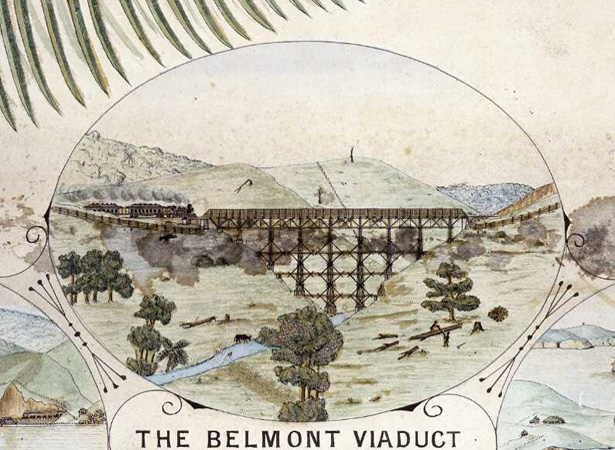
The Governor, Sir William Jervois, hammered home the ceremonial ‘last spike’ at Ōtaihanga, between Paraparaumu and Waikanae, to open a railway linking Wellington with Longburn, near Palmerston North.
Built by the privately owned Wellington and Manawatu Railway Company (WMR), the line would help open the Kāpiti Coast, Horowhenua and Manawatū to European settlement in the late 19th century, and later became part of the North Island Main Trunk Line.
In September 1880, after John Hall’s cost-cutting government abandoned work on a planned ‘West Coast Railway’ from Wellington to Foxton, the Wellington Chamber of Commerce rallied the city’s business leaders – many of whom owned land in Manawatū and Rangitīkei – to build their own line. Parliament passed enabling legislation offering generous land grants, and the WMR Company was registered in August 1881. The following March, 13 Wellington businessmen or firms, led by W.H. Levin, J.E. Nathan, John Plimmer, G.V. Shannon and J.S.M. Thompson, each bought 2000 £5 shares, a total investment equivalent to more than $23 million in 2020. Provided the line was completed within five years, the company would receive 85,000 ha of Crown land acquired (often by dubious means) from Māori owners; between 1882 and 1884 the WMR directly purchased a further 13,000 ha.
Although the company faced periodic financial problems, construction progressed swiftly. The 135-km route included a number of notable engineering features: one of the world’s largest wooden trestle bridges, the 38-m-high Belmont viaduct near Johnsonville; a string of tunnels along the steep Paekākāriki escarpment, where several lives were lost during construction; major bridges over the Pāuatahanui inlet and the Waikanae, Ōtaki and Manawatū rivers; and a raised embankment across the vast Makurerua (or Makerua) Swamp in Horowhenua.
As a reward for their contributions, the company named new settlements along the route after WMR directors Levin, Plimmer, Shannon and James Linton. The railway greatly improved access to the Manawatū region, fostered Palmerston North’s emergence as a major centre, and helped revive Wellington’s stuttering economy. Now connected by rail to Manawatū, Whanganui, New Plymouth and Wairarapa (and from 1891, Napier), the capital established itself as New Zealand’s transport and commercial hub.
For the next two decades, the important Wellington–New Plymouth route – coordinated with steamer services to Onehunga to provide the main link between Auckland and Wellington – was operated as a sometimes uneasy public–private partnership, with passengers switching to New Zealand Railways (NZR) trains at Longburn. The WMR had a strong American influence, and its powerful Baldwin locomotives, modern carriages and elegant dining cars often put their NZR counterparts to shame. In 1892 a WMR locomotive set a world speed record for the 3 foot 6 inch (1067 mm) gauge, averaging 68 km per hour over the 135-km route, with a top speed of 103 kph. The company continued to operate until 1908, when the completion of the North Island Main Trunk led to its purchase by the government.
Image: detail from decorative map published by the Wellington and Manawatu Railway Company. See zoomable version of this map on Te Ara.
How to cite this page
'Manawatū rail link opened', URL: https://nzhistory.govt.nz/page/manawatu-rail-link-opened, (Ministry for Culture and Heritage), updated 9-Nov-2023

Community contributions